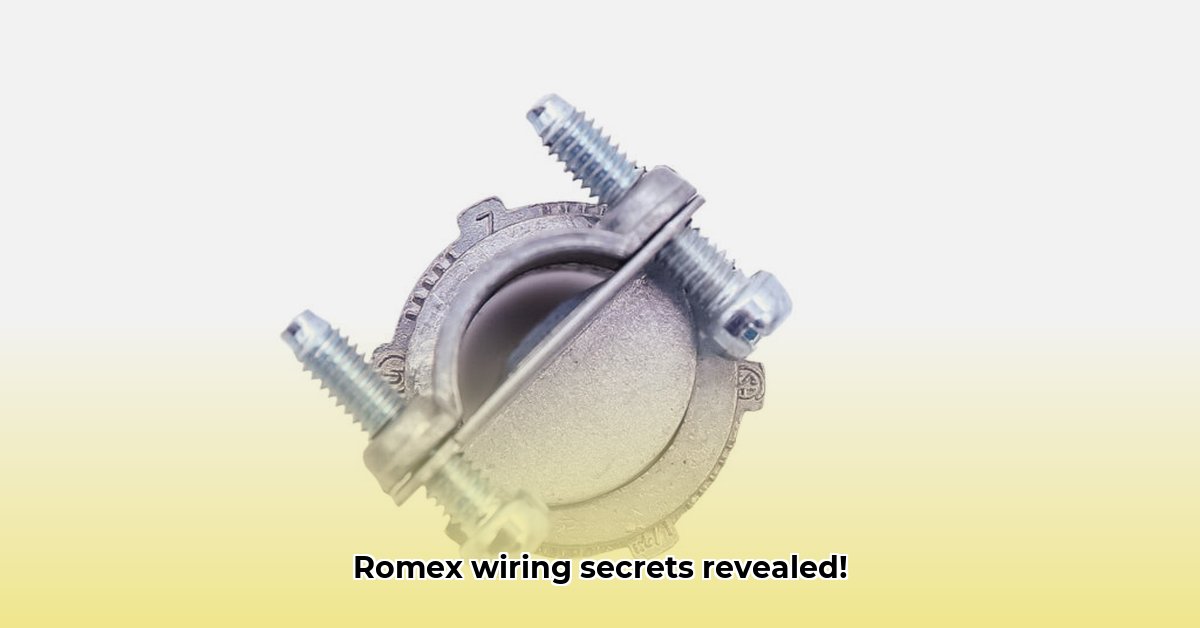Wiring your home may seem daunting at first, but mastering Romex connectors can significantly boost your confidence in handling electrical projects. This comprehensive guide provides a step-by-step walkthrough, covering everything from selecting the right connector to ensuring safe and correct installation. Whether you’re a seasoned DIY enthusiast or just starting out, we’ll explain the fundamentals in clear, accessible language. You’ll discover how to choose durable connectors, avoid common mistakes, and ensure your wiring adheres to all safety standards. This knowledge will empower you to confidently tackle your upcoming wiring tasks.
Romex Connectors: Your Guide to Safe Home Wiring
Let’s delve into Romex connectors, the often-overlooked components that are critical to your home’s electrical system. Understanding their role is essential for any wiring-related home improvement project, regardless of your experience level. Think of your home’s wiring as a network of roads, with Romex cables as the primary routes. Connectors are the carefully designed interchanges that maintain a smooth flow and prevent electrical hazards, much like preventing traffic jams. Adhering to safe wiring practices and using proper electrical connection methods is crucial.
Understanding Romex and Why Connectors Matter
Romex, also known as NM (non-metallic) cable, forms the backbone of most residential electrical systems. It carries electricity from your breaker box to outlets, switches, and lights. However, simply twisting wires together is not sufficient. You need appropriate connectors to establish secure, reliable connections that comply with electrical codes. Faulty connections can lead to overheating, sparks, or even house fires – risks you definitely want to avoid! Using the correct connectors is about ensuring safety and gaining peace of mind. It’s the critical difference between a well-functioning electrical system and a potential hazard. Did you know that faulty electrical connections are a leading cause of residential fires? Using the right connector helps ensure your electrical system operates smoothly and safely.
Different Connectors for Different Jobs: A Detailed Overview
Various types of Romex connectors are available, each engineered for specific applications. Selecting the wrong connector can lead to a range of problems, from loose connections to complete electrical failure. Here are some of the most common types, along with their typical uses and considerations:
- Wire Nuts (Marrettes): These are the everyday staples, commonly used for joining wires inside a junction box (the enclosure where wires connect). Ensure you choose the right size based on the number and gauge (thickness) of the wires you’re connecting. Using a wire nut that is too small is a common mistake that can lead to loose connections. Different colors indicate the size and capacity.
- Push-in Connectors: These offer convenience for quickly attaching wires to terminals in electrical boxes. They provide a fast, reliable solution, especially for smaller gauge wires. Simply insert the wires; however, always verify they are securely fastened. Some push-in connectors have test ports that allow you to check the connection with a multimeter.
- Split Bolt Connectors: These robust connectors are designed for heavy-duty applications, making them ideal for joining larger gauge wires (thicker wires that carry more current). They offer added security for high-amperage connections, such as those found in appliance circuits. These connectors typically require taping after installation to insulate the connection.
- Clamp Connectors (NM Cable Connectors): These connectors secure Romex cable to electrical boxes, preventing the cable from being pulled out and damaging the wires inside. They come in plastic or metal and are essential for code compliance. Different types are available for metal and non-metallic boxes.
- Set-Screw Connectors: Similar to clamp connectors, set-screw connectors use a screw to tighten and secure the cable. These are often used in metallic boxes and provide a very reliable connection.
Selecting the appropriate connector is essential for safety and performance. Using the wrong type can lead to future problems, such as loose connections, potential overheating, or even electrical shorts. Choosing the correct connector ensures a safe and reliable electrical connection that will last for years.
Picking the Right Connector: A Practical Guide
Selecting the correct connector depends on the wire size you’re using and the application. Here’s a more detailed reference guide:
| Wire Gauge (AWG) | Recommended Connector Type(s) | Important Considerations |
|---|---|---|
| 14-12 AWG | Wire Nuts, Push-in Connectors, NM Cable Connectors | Ideal for most household lighting and receptacle circuits; check the number of wires being joined. NM cable connectors are required where the cable enters the electrical box. |
| 10-8 AWG | Split Bolt Connectors, Clamp Connectors, Set-Screw Connectors | For higher amperage circuits like those for water heaters or dryers; ensure a secure connection and proper insulation. Ensure the connector is rated for the wire size and amperage. |
| Larger Gauges | Specialized connectors (consult an expert) | Always consult a qualified electrician for larger gauges used in main service panels or subpanels. These connections require specialized tools and expertise to ensure safety and code compliance. |
Always verify the amperage rating on your connector to ensure that it can safely handle the electrical current flowing through the wires. Using a connector with a lower rating than the wire’s amperage presents a significant safety hazard. Consult local electrical codes for specific requirements in your area.
Installing Romex Connectors: A Detailed Step-by-Step Guide
Before commencing any electrical work, always disconnect the power at the breaker box. This is the most critical safety precaution. A single mistake with live wires can lead to serious injury or even death. Use a non-contact voltage tester to confirm the circuit is de-energized before proceeding.
-
Gather your tools: Prepare your connectors, wire strippers, pliers, screwdrivers (if needed), and a non-contact voltage tester. Also, have electrical tape on hand for insulating connections.
-
Strip the wires: Carefully remove the insulation from the ends of your Romex wires, exposing approximately ½ inch of bare copper wire. Use wire strippers to avoid nicking or damaging the delicate strands. A poorly stripped wire creates a weak point in your connection.
-
Make the connection: Insert the bare wires into the connector, following the manufacturer’s instructions. For wire nuts, twist the wires together in a clockwise direction before applying the wire nut. Ensure all wire strands are firmly seated inside the connector. A loose connection is a leading cause of electrical problems.
-
Secure the connection: Tighten the connector as directed. It should be snug and secure, with no loose wires protruding. For wire nuts, give them a firm twist to ensure a tight connection. Properly securing the connection greatly reduces the risk of overheating and arcing.
-
Insulate (if applicable): For split bolt connectors, wrap the connection thoroughly with electrical tape to provide insulation. Overlap the tape layers to ensure complete coverage.
-
Inspect your work: Before restoring power, carefully check your connection for any potential issues, such as exposed or loose wires. Gently tug on each wire to ensure it’s securely held by the connector. Double-checking your work is a crucial safety step.
-
Organize wires in the box: Neatly fold the wires inside the electrical box, ensuring they are not overcrowded and that the connectors are not putting excessive pressure on the wires.
-
Secure the box (if applicable): Ensure the electrical box is properly mounted and secured to the wall or ceiling.
-
Power it up: Once you are certain that everything is correct and safe, carefully restore power at the breaker box.
Safety: Always the Top Priority
While some may believe they can handle electrical tasks on their own, working with electricity is inherently dangerous. If you’re uncertain about any aspect of this process or feel uncomfortable working with electricity, always consult a qualified electrician. Their expertise ensures installations are safe, compliant with codes, and performed to the highest standards. It’s far better to be cautious and seek professional help than to risk your safety and property.
Common Mistakes (and How to Avoid Them)
Let’s explore some common errors people make when working with Romex connectors and how to prevent them:
- Incorrect Connector Size: Using a connector that is too small for the number or gauge of the wires can cause loose connections, overheating, or even fires. Always select the appropriate size connector based on the manufacturer’s recommendations and the requirements of your wiring.
- Overcrowded Junction Boxes: Overfilling a junction box with too many wires significantly increases the risk of overheating. Ensure your junction boxes are not overcrowded. If they are, consider using larger boxes or adding more boxes to distribute the wiring more effectively. Adhere to National Electrical Code (NEC) fill requirements.
- Loose Connections: A loose connection is a fire hazard. Always ensure your connectors are firmly secured and that all wires are seated properly. Regularly inspect your connections for any signs of looseness or corrosion.
- Damaged Wire Insulation: Nicks or cuts in the wire insulation can create a potential short circuit or ground fault. Carefully strip the wires to avoid damaging the insulation. If you accidentally damage the insulation, wrap the affected area with electrical tape or replace the wire.
- Ignoring Grounding: Grounding is essential for safety. Ensure all ground wires are properly connected to the grounding terminal in the electrical box and to the grounding system.
- **Failing
- Backsplash For Gray Cabinets: Choosing the Right Backsplash Style - December 13, 2025
- Gray And White Backsplash: Ideas For Timeless Style - December 12, 2025
- Gray Kitchen Backsplash Ideas: Find Your Perfect Gray Tile - December 11, 2025









